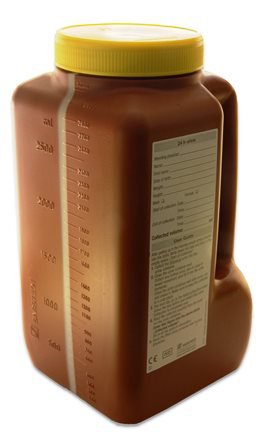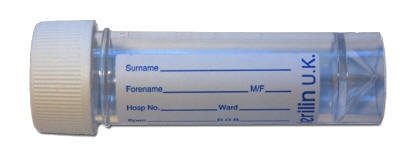Urate (Urine)
Chemical Pathology
Notes
- High uric acid levels in the urine are seen with gout, multiple myeloma, metastatic cancer, leukaemia and a diet high in purines.
- Those at risk of kidney stones who have high uric acid levels in their urine may be given medication to prevent stone formation.
- Low urine uric acid levels may be seen with kidney disease and chronic alcohol use.
Sample requirements
A complete 24h urine output, collected into a brown 3 litre container:

Bottles are available from the GP surgeries or from Pathology reception and phlebotomy at both Gloucester and Cheltenham Hospitals. These should be labelled with patient details and start and finish dates and times (please refer to patient information leaflet provided with the bottle for full instructions).
For children in whom a 24h urine collection is not possible, a urine urate:creatinine ratio can be measured.
This requires 5 ml urine taken into a 30mL white top Universal

Storage/transport
Random urine samples should be sent promptly to the laboratory at ambient temperature.
Timed urine collections should be transported to the laboratory as soon after the urine collection is completed and preferably within 24 hours of completion.
Samples will be alkalinised on receipt by the laboratory.
Required information
Relevant clinical details including reason for the request.
Turnaround times
The assays are run throughout the day Monday to Friday.
The in-lab turnaround time is normally less than 48 hours.
Reference ranges
Urine urate: 1.4 - 4.5 mmol/24h
For random urine samples, ( note: a 24 hour collection is always the preferred sample where this is possible):
| Age | Urine urate:creatinine ratio | Units |
| < 2 years | 0.4 - 1.5 | mmol/mmol |
| 2 - 6 years | 0.6 - 1.4 | mmol/mmol |
| 6 - 10 years | 0.4 - 0.9 | mmol/mmol |
| 10 - 18 years | 0.2 - 0.7 | mmol/mmol |
| > 18 years | 0.1 - 0.5 | mmol/mmol |
Further information
To learn more about urine urate visit Lab Tests Online
Page last updated 06/08/2014